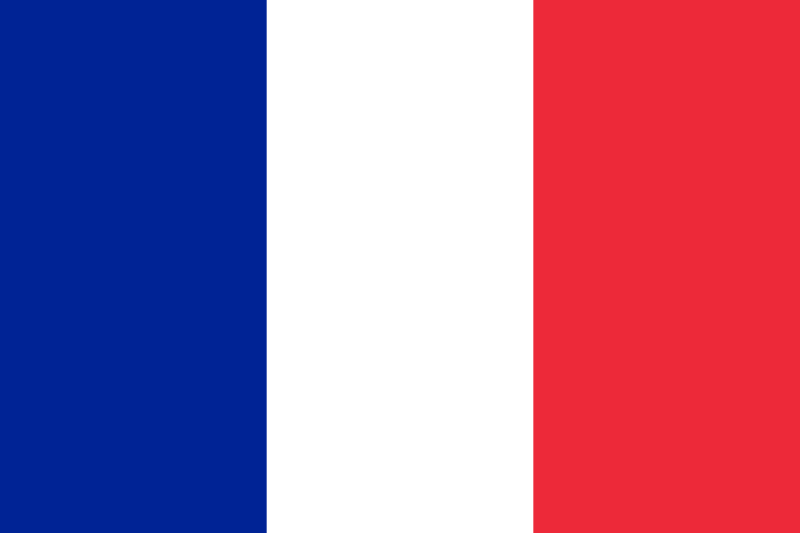National Symbols: Flag Details
Date First Used
February 15, 1794
Nickname(s)
"Le Tricolore" (Tricolor)
Design Elements
Three equal bands of blue, white and red, placed vertically so that blue is close to the staff of the flag (hoist), white in the middle, and red at the fly.
Symbols: None
Colors: Blue and red have been the colors of Paris since 1358, when they were used by the followers of Etienne Marcel, then-leader of a Parisian revolt against the King of France and the Dauphin. The white color may be linked to Joan of Arc and later, along with the fleur-de-lis, to the monarchy. Red, often associated with St. Denis, the patron saint of Paris, was used as the royal standard (oriflamme) during the Middle Ages.
Meanings subsequently have been ascribed to the colors. It is sometimes taught in French schools that the colors of the flag represent the three main estates of the Ancien Régime (white for the clergy, red for the nobility and blue for the bourgeoisie). Unofficially, the colors are often associated with the ideals of the French Revolution: liberty (blue), equality (white), and fraternity (red).
Color approximate specifications:
- Blue: Pantone 282c / CMYK (%) C 100 - M 70 - Y 0 - K 50
- Red: Pantone 186c / CMYK (%) C 0 - M 90 - Y 80 - K 5
Proportions: 2:3, with each of the three stripes constituting one-third of the flag
Variations: When the French flag is used at sea as a naval ensign, the respective proportions of the vertical blue, white and red stripes are 30:33:37 (unlike the Tricolore's equal-sized stripes). These optical proportions are used to give a good visual effect when flying.
History
No other flag, save for perhaps the US Stars and Stripes, offers such a potent symbol for popular revolution as does the French Tricolor. It was flown defiantly by anti-royalist factions during the French Revolution, and the French National Convention adopted it as the national flag on 27 Pluviôse of the Year II on the “Revolutionary Calendar” (a.k.a. February 15, 1794). It has since become a symbol of liberty around the world. However, since its original adoption the Tricolore’s turbulent career has reflected the similarly rocky post-revolution French political terrain.
After the restoration of the Bourbon monarchy following the defeat of Napoleon in 1815, the Tricolore—with all its Revolutionary connotations—was replaced by the pre-Revolutionary white flag of the Bourbons. However, following the July Revolution of 1830, the new "Citizen-King," Louis-Philippe, restored it as the national flag.
The Tricolore remained unchanged under the Second Republic and Second Empire. Following the overthrow of Napoleon III, voters elected a royalist majority to the National Assembly of the new Third Republic. This parliament then offered the throne to the Bourbon pretender, Henri, Comte de Chambord. Henri insisted he would only accept the throne on the condition that the Tricolore be replaced by the white flag. As the Tricolore had become a cherished national symbol, this proved impossible—and plans to restore the monarchy were ultimately dropped. France continued on as a republic, and the constitutions of 1946 and 1958 instituted the Tricolore as the national emblem, which it has remained ever since.
Proper Use
Most French flag protocol refers to the use of the national ensign (military flag). Vessel captains shall hoist the national ensign when entering or leaving a port or upon any request by a French or foreign war vessel. In ports and harbors, the captains of French merchant, fishery, and yachting vessels are required to hoist the national ensign on Sundays, public and official holidays, in any circumstance concerning water and port police or maritime police, upon request by Maritime Prefects or Navy Commanders in military ports, by the Administrator of Maritime Affairs in commercial ports, and by the French Consuls in the foreign ports.
Legends, Controversies, and Trivia
Initially, the three stripes of the flag were not equally wide, being in the proportions 30 (blue), 33 (white) and 37 (red). The theory behind this was that if they were equal then the white stripe, being brighter, would appear disproportionately wider to the human eye. Under Napoleon I the proportions were changed to make the stripes' width equal, but by a regulation dated May 17,1853, the Navy went back to using the 30:33:37 proportions, which it continues to use.
The Vichy régime (a puppet regime installed after German occupation in WWII) dropped the word "republic" in favour of "the French state," but maintained the use of the Tricolore. However, regime leader Philippe Pétain used a version with fasces (a bundle of sticks symbolizing summary power and jurisdiction) and stars as a personal standard. That flag became known as the "Francisque."
During World War II, Free French Forces, led by future French president General Charles de Gaulle, used a Tricolore featuring a red Cross of Lorraine in their efforts to overthrow the Vichy regime and Axis powers. Naval officer Thierry d'Argenlieu suggested the adoption of the Cross of Lorraine as a symbol of the Free French both to recall the perseverance of Joan of Arc, whose emblem it had been, and as a rebuttal to the Nazi swastika. In his general order no. 2 of July 3, 1940—two days after assuming the post of chief of the naval and air forces of the Free French—Vice Admiral Émile Muselier created the bow flag displaying the French colors with the red cross.
Copyright © 1993—2025 World Trade Press. All rights reserved.

 France
France 